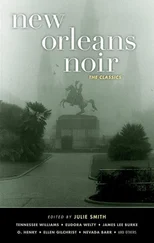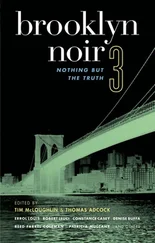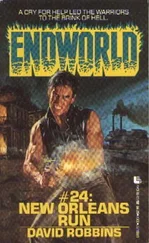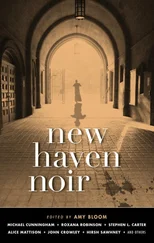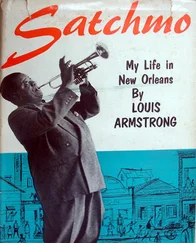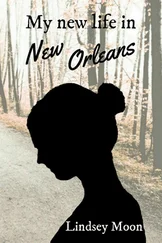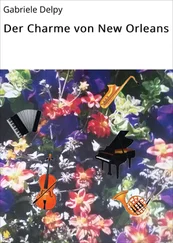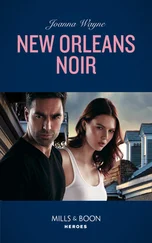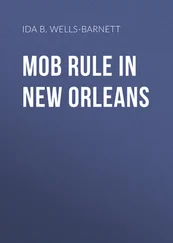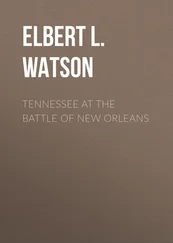What else I know about New Orleans? One or two things. They got some scruffy white people here. Scary looking. Take these three. Just beat to shit, generally. I mean, the dead guy, the vic, literally. One of the women, the girlfriend, five-nine, two-fifty, told the parish deputies she was a man, and they believed her. And the other one, the wife. Kinda scrawny and twitchy. And why on earth didn’t they get rid of the body? Oh, they were fixin’ to, but just “hadn’t got around to it.” Even bought some fishing poles. They were gonna take the footlocker out in the Gulf and dump it overboard. Plus, they got to drinkin’, to fuckin’ and fightin’ again, one thing and another, and just plum lost track of the time.
One or two other things I know about New Orleans is the pull of the past. Never been anywhere the past had such a pull on a person as here. If I had me a time machine, I’d wear it out, me, and I wouldn’t be hitting no future button, no, no, no. Even if there was one. No, I’d dial me up old New Orleans. The French Opera House. Storyville. Lulu White’s Mahogany Hall. The New Basin Canal. Not even that far back. I’d be just as happy to hitch a ride back to the ’50s. South Rampart Street honky tonks and gin joints and every mobbed-up club in town before that self-righteous prick Jim Garrison shut them all down. Not that I could go in those places back then, not through the front door anyway. But still. All the glorious past.
So much gone now, so much vanished. The Dew Drop Inn. Old Chinatown where City Hall is now. The amusement parks at Pontchartrain Beach and Milneburg and Old Spanish Fort and Lincoln Beach. North Claiborne before they tore up the old oak trees with bulldozers and rammed the interstate down our throats. Funny they didn’t run it through Uptown, ain’t it? I suppose I could use that time machine to go forward to when somebody apologizes for that, huh? I could set it for, let’s see, turn the dial to When Hell Freezes Over. I’ll be there.
We used to all picnic on Mardi Gras day on North Claiborne, wait for the Indians to congregate. Still do, but instead of under the live oak trees, now it’s in the shade of the freeway. Pathetic, huh? We’re stubborn, or stupid. Set in our ways.
So much gone. I’d give anything to see the glorious past of New Orleans. The octoroon balls. The slave market. Congo Square. I’d wanna see all that. One of the perks of this job, it teaches you not to flinch. The glorious and horrible past of New Orleans. Almost makes you believe in karma, doesn’t it? This beautiful place, paradise on earth, the City That Care Forgot, built on blood and tears and human misery.
I sometimes wonder if maybe that’s why this job keeps me so busy. In the words of that great Southern writer, the past ain’t never past, is it? But you knew that, didn’t you? Don’t need me to tell you. We all know that. No excuse, anyway. You can’t be blaming karma when you kill somebody. You can’t go crying about history when you blow some old lady away. Shoot some tourist in a cemetery, just some ordinary nobody checking out our great and glorious past. But still, I get to thinking sometimes, wondering when the past is gonna run its course here in the Crescent City. Wondering when we ever gonna get past the past.
Oh, I’d give that time machine a workout. Doesn’t have to be so far back. I’d settle for thirty years ago, when the parades still snaked through the Quarter on Mardi Gras day. Hell, I’d settle for last Saturday night, about 10 o’clock, when all this bullshit went down.
I mean, it’s not a mystery, exactly, but I’d still like to know. What was said. Did they plan to do him, the two of them? Did he know that she was more than just his wife’s friend? Did he come home and catch them going at it? Or maybe he was into it and they weren’t? Or they weren’t anymore? How long, in the words of that old song, had this been going on, anyway? Kind of case that keeps them speculating at work, you know?
Homicide. Our day starts when your day ends. Some of us have that on a T-shirt. Baseball cap. People say it ain’t respectful. But you gotta have a sense of humor in this job. I know that too.

Thomas Adcockis an Edgar Award — winning author of six novels, including Thrown-Away Child , set in New Orleans. He is a reporter for the New York Law Journal. Twenty-five years ago, thanks to marrying the New Orleans — born actress Kim Sykes, the Crescent City became his second home.

Ace Atkinscovered the immediate aftermath of Hurricane Katrina in New Orleans and the Gulf Coast for Outside Magazine . The Pulitzer Prize — nominated journalist is also the author of four crime novels based in and around the city. He lives and writes in Oxford, Mississippi.

Patty Friedmannhas lived in New Orleans all her life, except for slight interruptions for education and natural disasters. Her darkly comic novels include Eleanor Rushing, Secondhand Smoke, and A Little Bit Ruined. Her works have been selections of the Barnes & Noble Discover Great New Writers Program and Borders Original Voices, and Book Sense 76 picks.

David Fulmer’s Chasing the Devil’s Tail, a mystery set in turn-of-the-century Storyville, New Orleans, won a Shamus Award and was a finalist for a Los Angeles Times Book Prize, a Barry Award, and a Falcon Award. His Storyville novels Jass and Rampart Street have drawn high praise. He lives in Atlanta with his daughter Italia.

Barbara Hamblywas born in San Diego, California, and originally trained as an academic historian. She lived part-time in New Orleans for three years while married to science fiction writer George Alec Effinger; she now lives in Los Angeles.

Greg Herrenis the author of six mystery novels set in New Orleans, including Mardi Gras Mambo and Murder in the Rue Chartres (forthcoming). He lives in the Lower Garden District of New Orleans and refuses to relocate. Ever.

Laura Lippman, a Baltimore-based writer best known for her award-winning Tess Monaghan novels, believes New Orleans is the only other city where she could be happy for more than a few days, preferably December through March.

Tim McLoughlinis the editor of the multiple award — winning anthology Brooklyn Noir. His novel, Heart of the Old Country, was a selection of the Barnes and Noble Discover Great New Writers Program and won Italy’s Premio Penne award. He was married in St. Mary’s Chapel on Jackson Avenue in the Garden District.

James Nolan, a fifth-generation New Orleans native, is a widely published poet, fiction writer, essayist, and translator. His collections of poetry are Why I Live in the Forest and What Moves Is Not the Wind , both from Wesleyan University Press. He is a regular contributor to Boulevard , and recent stories have come out in Shenandoah , the Southern Review, and the Chattahoochee Review . He lives in the French Quarter, and currently directs the Loyola Writing Institute at Loyola University.
Читать дальше










